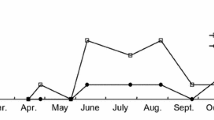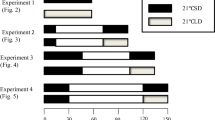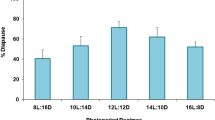Abstract
Many insects in temperate zones withstand the adverse conditions of winter through entering diapause and the two most important environmental stimuli that induce diapause are photoperiod and ambient temperature. The Large Copper butterfly, Lycaena dispar Haworth (Lepidoptera: Lycaenidae), is a Palearctic butterfly that hibernates as larvae. Since this butterfly is a near threatened species in some regions, there has been a growing need for a standardized protocol for mass rearing of this butterfly based on the adequate knowledge of its ecology. In the present study, we first identified that L. dispar larvae were sensitive to the photoperiodic induction of diapause during their first larval instar. We then investigated to what extent the diapause-inducing effects of photoperiod could be modified by ambient temperatures in L. dispar larvae by exposing them to the range of day-lengths (L:D 14:10, 12:12, 10:14 and 8:16) at three different temperatures (15, 20 and 25 °C). All larvae were induced to enter diapause at low ambient temperature (15 °C) regardless of photoperiod, whereas most of them (86 %) exhibited direct development when temperature was high (25 °C). The photoperiodic induction of diapause was evident when day-length was shorter than 14 h at intermediate temperature (20 °C). Pre-diapause development was prolonged at low temperatures. Finally, we found that post-diapause development of L. dispar larvae was determined by both the chilling temperature experienced by diapausing larvae and the duration of larval diapause. Adult emergence was enhanced when larvae were chilled at 8 °C and when they had been under the state of diapause for 20 days before they were treated to terminate diapause.






Similar content being viewed by others
References
Beck SD (1980) Insect photoperiodism, 2nd edn. Academic Press, New York
Crawley MJ (2007) The R book. Wiley & Sons Ltd, Chichester
Denlinger DL (2002) Regulation of diapause. Annu Rev Entomol 47:93–122
Duffey E (1968) Ecological studies on the Large Copper butterfly Lycaena dispar Haw. batavus Obth. at Woodwalton Fen National Nature Reserve, Huntingdonshire. J Appl Ecol 5:69–96
Duffey E (1977) The-re-establishment of the Large Copper butterfly Lycaena dispar batava Obth.on Woodwalton fen nature reserve, Cambridge, England, 1969–1973. Biol Conserv 12:143–158
Esperk T, Tammaru T, Nylin S (2007) Intraspecific variability in number of larval instars in insects. J Econ Entomol 100:627–645
Fischer K, Fiedler K (2001) Sexual differences in life-history traits in the butterfly Lycaena tityrus: a comparison between direct and diapause development. Entomol Exp Appl 100:325–330
Higaki M, Ando Y (2005) Effects of temperature during chilling and pre-chilling periods on diapause and post-diapause development in a katydid, Eobiana engelhardti subtropica. J Insect Physiol 51:709–716
Hodek I (1996) Diapause development, diapause termination and the end of diapause. Eur J Entomol 93:475–487
Hodek I (1999) Environmental regulation and some neglected aspects of insect diapause. Entomol Sci 2:533–537
Hodek I (2002) Controversial aspects of diapause development. Eur J Entomol 99:163–173
Honěk A (1993) Intraspecific variation in body size and fecundity in insects: a general relationship. Oikos 66:483–492
Jiang XF, Huang SH, Luo LZ, Liu YQ, Zhang L (2010) Diapause termination, post-diapause development and reproduction in the beet webworm, Loxostege sticticalis (Lepidoptera: Pyralidae). J Insect Physiol 56:1325–1331
Kim SS (2012) Life histories of Korean butterflies. Paju, Sakyejul
Kim SH, Hong SJ, Lee YB, Park HC, Je YH, Kim NJ (2011) Physiological characteristics of the Large Copper butterfly, Lycaena dispar (Lepidoptera: Lycaenidae). Int J Ind Entomol 23:215–221
Koštál V (2006) Eco-physiological phases of insect diapause. J Insect Physiol 52:113–127
Lees AD (1955) The physiology of diapause in arthropods. Cambridge University Press, Cambridge
Martin LA, Pullin AS (2004a) Host-plant specialisation and habitat restriction in an endangered insect, Lycaena dispar batavus I. Larval feeding and oviposition preferences. Eur J Entomol 101:51–56
Martin LA, Pullin AS (2004b) Host-plant specialisation and habitat restriction in an endangered insect, Lycaena dispar batavus II. Larval survival on alternative host plants in the field. Eur J Entomol 101:57–62
Nijhout HF (1975) A threshold size for metamorphosis in the tobacco hornworm, Manduca sexta. Biol Bull 149:214–225
Pullin AS, Bálint Z, Balletto E, Buszko J, Coutsis JG, Goffart P, Kulfan M, Lhonoré JE, Settele J, van der Made JG (1998) The status, ecology and conservation of Lycaena dispar (Lycaenidae: Lycaenini) in Europe. Nota Lepidopterol 21:94–100
R Core Team (2014) R: a language and environment for statistical computing. R Foundation for Statistical Computing, Vienna, Austria. http://www.r-project.org. Accessed 22 June 2014
Saunders DS (1971) The temperature-compensated photoperiodic clock ‘programming’ development and pupal diapause in the fresh-fly, Sarcophaga argyrostoma. J Insect Physiol 17:801–812
Saunders DS (2002) Insect clocks, 3rd edn. Elsevier Science, Amsterdam
Strausz M, Fiedler K, Franzén M, Wiemers M (2012) Habitat and host plant use of the Large Copper butterfly Lycaena dispar in an urban environment. J Insect Conserv 16:709–721
Tauber MJ, Tauber CA (1976) Insect seasonality: diapause maintenance, termination, and postdiapause development. Annu Rev Entomol 21:81–107
Tauber MJ, Tauber CA, Masaki S (1986) Seasonal adaptations of insects. Oxford University Press, Oxford
Thomas JA, Simcox DJ, Clarke RT (2009) Successful conservation of a threatened Maculinea butterfly. Science 325:80–83
Acknowledgments
We would like to thank an anonymous reviewer for his/her constructive input to this manuscript. This work was supported by the Next-Generation BioGreen 21 Program (PJ00818604) from Rural Development Administration (RDA) of Republic of Korea.
Author information
Authors and Affiliations
Corresponding author
Rights and permissions
About this article
Cite this article
Kim, SH., Kim, N.J., Hong, SJ. et al. Environmental induction of larval diapause and life-history consequences of post-diapause development in the Large Copper butterfly, Lycaena dispar (Lepidoptera: Lycaenidae). J Insect Conserv 18, 693–700 (2014). https://doi.org/10.1007/s10841-014-9678-9
Received:
Accepted:
Published:
Issue Date:
DOI: https://doi.org/10.1007/s10841-014-9678-9




